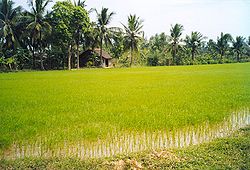Bến Tre province
Province of Vietnam From Wikipedia, the free encyclopedia
Province of Vietnam From Wikipedia, the free encyclopedia
Bến Tre is a province of Vietnam. It is one of the country's southern provinces, and is situated in the Mekong Delta. It is also famous for its coconuts and the Coconut Religion nationwide. Disconnected from the mainland, the province lies mainly on 2 river islands. It has land borders only with Vĩnh Long Province, which occupies the western tip of the southern river island.
Bến Tre
Kiến Hòa | |
|---|---|
| Bến Tre province | |
 Bến Tre countryside around Cái Mơn | |
| Nickname: Land of Coconuts | |
 Location of Bến Tre within Vietnam | |
 | |
| Coordinates: 10°10′N 106°30′E | |
| Country | |
| Region | Mekong Delta |
| Provincial capital | Bến Tre |
| Government | |
| • Body | Bến Tre provincial Party Committee |
| • People's Council Chair | Hồ Thị Hoàng Yến (Communist Party of Vietnam) |
| • People's Committee Chair | Trần Ngọc Tam |
| Area | |
| • Total | 2,379.70 km2 (918.81 sq mi) |
| Population (2023) | |
| • Total | 1,799,328 |
| • Density | 760/km2 (2,000/sq mi) |
| Demonym | People of Bến Tre |
| Demographics | |
| • Ethnicities | Vietnamese, Khmer, Hoa, Chăm |
| GDP[2] | |
| • Total | VND 41.851 trillion US$ 1.818 billion |
| Time zone | UTC+7 (ICT) |
| Postal code | 86xxx |
| Area codes | 75 (until 16 July 2017) 275 (from 17 June 2017) |
| ISO 3166 code | VN-50 |
| HDI (2020) | (49th) |
| Website | www |
The origin of the province’s name is still unclear as it was first inhabited by the Khmer people, though some speculated it may have been called Kompong Russei. Its original name was then later altered by incoming waves of immigration and settlement by ethnic Vietnamese into Bến Tre.[4] In Vietnamese, “Bến Tre” literally means “bamboo port”, which is quite inaccurate considering it is regionally famous for its Coconuts.
In what has been called "the start of the Vietnam War", in January and February 1960, the Việt Cộng attacked and took temporary control of several districts in Bến Tre, then known as Kiến Hòa.[5] The Việt Cộng set up "people's committees", and confiscated land from landlords and redistributed it to poor farmers. One of the leaders of the uprising was Madame Nguyễn Thị Định, who led the all-female "Long Hair Army".
Although the South Vietnamese army (ARVN) recaptured the villages, uprisings spread to many other areas of South Vietnam. The uprisings were spontaneous rather than planned.[6]
Bến Tre is subdivided into 9 district-level subdivisions. The eight districts are Ba Tri, Bình Đại, Châu Thành, Chợ Lách, Giồng Trôm, Mỏ Cày Bắc, Mỏ Cày Nam, and Thạnh Phú. There is also one provincial city of Bến Tre (capital). They are further subdivided into 7 commune-level towns (or townlets), 147 communes, and 10 wards. To view the list of subdivisions, see List of communes in Bến Tre province.
Geographically, Bến Tre is wedged between the two main branches of the Tiền Giang River, which is itself one of the two main distributary of the Mekong. The province's northern boundary is formed by the Tiền Giang's main course, while the province's southern boundary is formed by the Tiền Giang's largest branch (which breaks away from the Tiền Giang just upriver from Bến Tre province). Between the Tiền Giang and its main branch are two smaller branches, passing through the middle of Bến Tre. As a result, this province may be considered having 2 main river islands and has land borders only with Vĩnh Long Province on its western tip.
The entire province is criss-crossed with a network of smaller rivers and canals. The extensive irrigation that this provides makes Bến Tre a major producer of rice, but also means that the area is prone to flooding. The Climate Change Research Institute at Cần Thơ University, in studying the possible consequences of climate change, has predicted that 51% of Bến Tre province can be expected to be flooded if sea levels rise by 1 meter.[7] Bến Tre province is, on average, only 1.25 meters (4 ft 1 in) above sea level.
This section is empty. You can help by adding to it. (November 2024) |
This section is empty. You can help by adding to it. (November 2024) |
This section is empty. You can help by adding to it. (November 2024) |
This section is empty. You can help by adding to it. (November 2024) |
This section is empty. You can help by adding to it. (November 2024) |
This section is empty. You can help by adding to it. (November 2024) |
Construction on the Rạch Miễu Bridge, which links Bến Tre to neighboring Tiền Giang province to its north, was started in 2002. The bridge was finished and opened for traffic on 19 January 2009. Before that time, Bến Tre was only accessible to automobiles via ferry.
Seamless Wikipedia browsing. On steroids.
Every time you click a link to Wikipedia, Wiktionary or Wikiquote in your browser's search results, it will show the modern Wikiwand interface.
Wikiwand extension is a five stars, simple, with minimum permission required to keep your browsing private, safe and transparent.